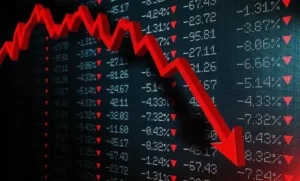Famous economist Harry Dent has issued a grave warning, predicting a stock market decline that will be even worse than the Great Recession. Founder of HS Dent Investment Management and well-known for his candid opinions on the US economy, Dent cautioned investors on June 11, in an interview with Fox News that the recent market gains are only a prelude to the storm.
Dent asserted that the “everything” bubble hasn’t burst as of yet, and when it does, it would be the “crash of a lifetime.”
He further explained, “And again, this bubble has been going 14 years. Instead of most bubbles [going] five to six, it’s been stretched higher, longer. So you’d have to expect a bigger crash than we got in 2008 to ’09.”

Dent used historical market crashes, like the one that occurred in 1929, to highlight the peculiarities of the current market. He made the argument that the current market bubble has been artificially inflated by prolonged monetary stimulus measures, in contrast to earlier booms. Dent issued a warning, stating that this bubble’s 14-year lifespan is paving the way for an unprecedented collapse.
Bubbles illustrate the dangers of irrational rise and overvaluation in financial markets
Market Projections
Dent forecast sharp declines in significant market indices, including the Nasdaq and S&P. He projected a stunning 92% decline in the Nasdaq index and an 86% loss in the S&P. Dent cautioned that even well-performing stocks, such as Nvidia, might drop by 98%.
Harry Dent’s expert analyses
Dent’s worries contrast with the current euphoria in the market, particularly for tech stocks like NVIDIA. Dent, however, emphasized that the current state of affairs is untenable and cautioned investors to prepare for a sharp decline.
About Harry Dent

Harry Dent, 71-year-old, founder of HS Dent Investment Management, is well-known for his forthright views on the U.S. economy. His 2009 book, “The Great Depression Ahead,” was a New York Times Bestseller.
Global Financial Crises of 2008 quoted by Harry Dent
The 2007–2008 financial crisis, also known as the global financial crisis (GFC), stands out as the most severe worldwide economic crisis since the Great Depression.
- 2000-2006: The housing market bubble inflated due to lax lending practices, low interest rates and high demand for mortgage-backed securities.
- 2007: Signs of trouble emerged as default rates on subprime mortgages rose, leading to the collapse of several subprime lenders.
- March 2008: In order to keep Bear Stearns, a significant investment bank, afloat, the Federal Reserve provided financial support.

Lehman Brothers - September 2008: The bankruptcy filing of well-known investment bank Lehman Brothers shocked the financial markets.
- September 2008: In order to keep American International Group (AIG), one of the biggest insurance companies in the world, afloat, the U.S. government provided financial support.
- 2008–2009: Global economies went into a deep recession, stock markets crashed, and credit markets froze.
- 2009 saw the implementation of stimulus plans and bailouts by governments all over the world in an effort to stabilize financial institutions and spur economic expansion.
Aftereffects: In an effort to avert another catastrophe of this nature, the financial sector has been subject to heightened regulation, exemplified by the Dodd-Frank Act in the United States.
How was India Affected During the 2008 Crisis?
India did not experience the same level of hardship during the 2008 financial crisis as several other nations due to:
Limited Exposure: The banking system in India, as well as the country’s financial industry overall, had little to no global market integration and little exposure to mortgage-backed securities. India was insulated from the crisis’s direct negative effects.
Integration of the Real Economy: On the other hand, trade and money flows worldwide have become more and more connected with India’s “real economy.” India felt the “second round” consequences of the financial crisis as it transformed into a global economic depression.
Trade Collapse: The decoupling myth about the Indian economy was debunked as exports from India declined in tandem with global trade flows. Exchange rate fluctuations, money flows, and collapsing international trade all had an adverse effect on India.
Trade Intensity: Compared to overall economic activity, the synchronized trade collapse during the Great Recession was more severe. As a transmission mechanism, globalization—which is typified by increasing trade intensity—affected even nations with comparatively sound financial systems.
Trade Finances: An estimated 10% to 15% decline in global commerce occurred during the crisis, with trade finance accounting for 80% of trade flows.









